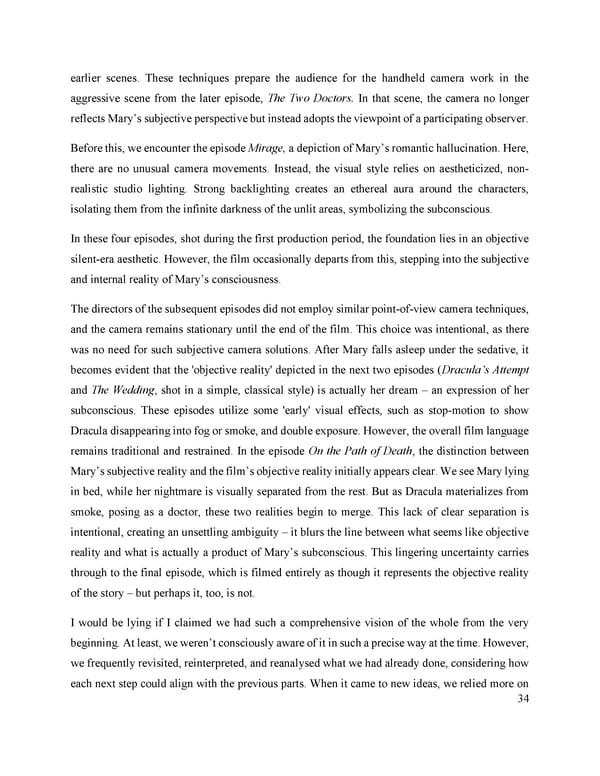earlier scenes. These techniques prepare the audience for the handheld camera work in the aggressive scene from the later episode, The Two Doctors. In that scene, the camera no longer reflects Mary’s subjective perspective but instead adopts the viewpoint of a participating observer. Before this, we encounter the episode Mirage, a depiction of Mary’s romantic hallucination. Here, there are no unusual camera movements. Instead, the visual style relies on aestheticized, non- realistic studio lighting. Strong backlighting creates an ethereal aura around the characters, isolating them from the infinite darkness of the unlit areas, symbolizing the subconscious. In these four episodes, shot during the first production period, the foundation lies in an objective silent-era aesthetic. However, the film occasionally departs from this, stepping into the subjective and internal reality of Mary’s consciousness. The directors of the subsequent episodes did not employ similar point-of-view camera techniques, and the camera remains stationary until the end of the film. This choice was intentional, as there was no need for such subjective camera solutions. After Mary falls asleep under the sedative, it becomes evident that the 'objective reality' depicted in the next two episodes (Dracula’s Attempt and The Wedding, shot in a simple, classical style) is actually her dream – an expression of her subconscious. These episodes utilize some 'early' visual effects, such as stop-motion to show Dracula disappearing into fog or smoke, and double exposure. However, the overall film language remains traditional and restrained. In the episode On the Path of Death, the distinction between Mary’s subjective reality and the film’s objective reality initially appears clear. We see Mary lying in bed, while her nightmare is visually separated from the rest. But as Dracula materializes from smoke, posing as a doctor, these two realities begin to merge. This lack of clear separation is intentional, creating an unsettling ambiguity – it blurs the line between what seems like objective reality and what is actually a product of Mary’s subconscious. This lingering uncertainty carries through to the final episode, which is filmed entirely as though it represents the objective reality of the story – but perhaps it, too, is not. I would be lying if I claimed we had such a comprehensive vision of the whole from the very beginning. At least, we weren’t consciously aware of it in such a precise way at the time. However, we frequently revisited, reinterpreted, and reanalysed what we had already done, considering how each next step could align with the previous parts. When it came to new ideas, we relied more on 34
 Lost Analogue: Exploring Film, Music, and Interdisciplinary Methods in Education Page 34 Page 36
Lost Analogue: Exploring Film, Music, and Interdisciplinary Methods in Education Page 34 Page 36